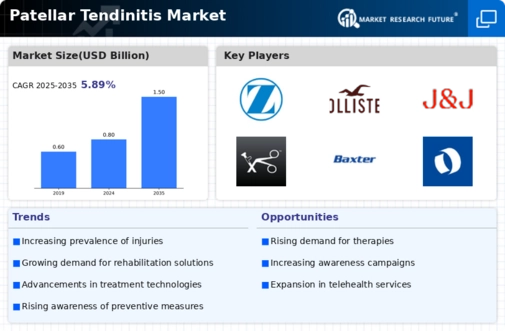Rising Healthcare Expenditure
The increase in healthcare expenditure across various regions appears to be positively impacting the Patellar Tendinitis Market. As healthcare budgets expand, there is a greater allocation of resources towards orthopedic treatments and rehabilitation services. This trend is likely to facilitate access to advanced treatment options for patellar tendinitis, including physical therapy and surgical interventions. Furthermore, higher healthcare spending may encourage research and development initiatives aimed at improving treatment efficacy. As a result, the financial commitment to healthcare is expected to drive growth and innovation within the Patellar Tendinitis Market.
Increase in Sports Participation
The rise in sports participation across various age groups appears to be a significant driver for the Patellar Tendinitis Market. As more individuals engage in sports and physical activities, the incidence of patellar tendinitis is likely to increase. This condition is particularly prevalent among athletes involved in high-impact sports such as basketball, soccer, and running. According to recent data, the number of individuals participating in organized sports has surged, leading to a corresponding rise in sports-related injuries. Consequently, this trend may drive demand for effective treatment options and rehabilitation services within the Patellar Tendinitis Market.
Advancements in Medical Technology
Technological advancements in medical treatments and diagnostic tools seem to be transforming the Patellar Tendinitis Market. Innovations such as ultrasound imaging and MRI have enhanced the ability to diagnose patellar tendinitis accurately, allowing for timely intervention. Furthermore, the development of minimally invasive surgical techniques and regenerative medicine, including platelet-rich plasma therapy, has expanded treatment options. These advancements not only improve patient outcomes but also increase the overall efficiency of healthcare delivery. As a result, the integration of cutting-edge technology is likely to propel growth within the Patellar Tendinitis Market.
Growing Awareness of Sports Injuries
There appears to be a growing awareness regarding sports injuries and their long-term implications, which is influencing the Patellar Tendinitis Market. Educational campaigns and initiatives by sports organizations and healthcare providers are helping to inform athletes and coaches about the risks associated with patellar tendinitis. This heightened awareness may lead to increased demand for preventive measures, early diagnosis, and effective treatment options. As more individuals recognize the importance of addressing sports injuries promptly, the market for patellar tendinitis treatments is expected to expand, reflecting a proactive approach to sports health.
Aging Population and Joint Health Concerns
The aging population is likely to be a crucial driver for the Patellar Tendinitis Market. As individuals age, they may experience a decline in joint health, making them more susceptible to conditions like patellar tendinitis. This demographic shift suggests an increasing need for effective treatment options tailored to older adults. Moreover, the prevalence of comorbidities such as obesity and arthritis among the elderly may exacerbate the incidence of patellar tendinitis. Consequently, healthcare providers may focus on developing targeted therapies and rehabilitation programs to address the unique needs of this population, thereby fostering growth in the Patellar Tendinitis Market.


















Leave a Comment